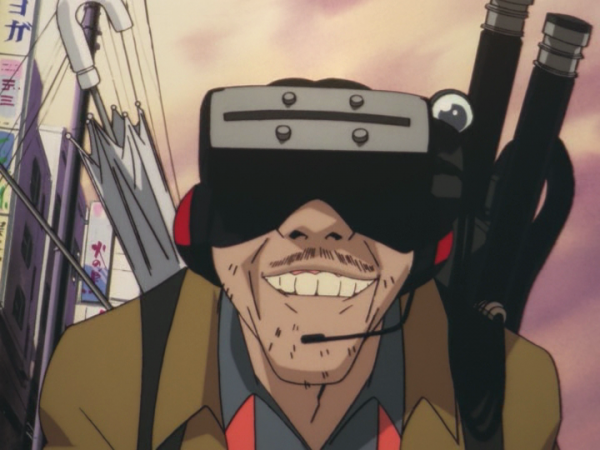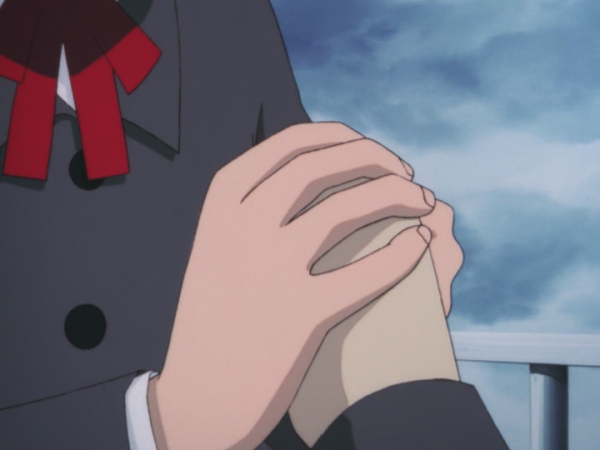Society
As we return to serial experiments lain, the voice-over for Layer 07: Society tells us, “Just between you and me, let me tell you what’s happening, what’s beginning to take place in our society without you ever even being vaguely conscious of it.” In this episode, we’re introduced to Nezumi and his rad portable computer, as well as a few of the Knights. Alice talks to Lain on the school rooftop, again about her social withdrawal. The MIBs take Lain to a Tachibana General Laboratories office; they have a discussion about the Wired and he questions Lain about her identity.

Let’s start with Lain’s progress. At the beginning of the episode she notes that “the me in the Wired is […] becoming less and less like me.” She also comments that her sister has been acting strangely, though she doesn’t seem to connect it with the apparition of Mika she saw in the doorway in Layer 05. Anyway, at school Lain says to herself “The real world isn’t real at all,” having apparently internalised the Knights’ message to her. One nice touch in the following conversation with Alice is that she actually takes Lain’s hand, as a sign of friendship but also serving as a reminder to Lain that of course the real world exists - she can feel Alice’s hand right now. It’s the common sense counter to Lain’s digital solipsism.


Not that this lasts too long. At the end of the episode the Tachibana boss asks Lain seemingly simple questions like when her parents’ birthdays are, how they met, and when and where she was born, and Lain starts to panic when she can’t answer them. Interestingly, Lain’s personality changes at this point into the aggressive, irritable Lain of the Wired that we saw in Cyberia. She said at the beginning of the episode that this online version of herself is becoming less like her, yet she’s becoming more like that Wired version of herself. What seems to be happening is that Lain doesn’t like this persona and so wants to distance herself from it, yet as the boundary between the Wired and the real world continues to dissolve her personae unite rather than separate.
We can also gather that that line is dissolving because of the news report which tells us it may arrive “tomorrow, or possibly yesterday.” Even time is affected by the Wired.
As for Nezumi, I admit that I like this character a lot, even if he only lasts this one episode. He’s apparently skilled enough to get into one of the Knights’ discussion channels, but presumably they kill him because he’s too much of a crank to let in. He has that very human desire to be recognised and applauded by high status people, and the Knights are the highest status group on the Wired. Unfortunately, he’s merely an opportunist who’ll say or do whatever he thinks the Knights want to hear, and so they rightfully don’t want him. Of course, it’s wise for any organisation to carefully filter who they let in, especially if they plan to do anything of importance. Quality over quantity!
One last thing I’d like to address is a comment from the Tachibana boss. “Some say that the Wired doesn’t have political borders like the real world. But there are far too many nonsense-spouting anarchists or idiots who think that pranks are a revolution.” He adds that the Knights are not such a group and so are more serious, but his observation was certainly true in the techno-utopian 1990s and remains true today.

One excellent source of examples is Douglas Rushkoff’s 1994 book Cyberia (yes, this is where lain’s night club takes its name). In it, Rushkoff interviews several hackers who attack major corporations, or even steal debit card information from sufficiently well-off people. What, though, have they accomplished? Not a damn thing. All they did was annoy some businessmen and keep some IT departments busy.
They also discuss the promise of open communication and access to information that the internet could provide. However, today the internet certainly has its political borders in the form of various cliques and specialised websites, and these groups even wage war against each other in the form of memes (in the broad sense, not just image macros), trolling, DDOS attacks, and the like. This is especially true if one hangs around fringe groups, though cyberian warfare does occasionally spill over into normie territory.
Have these newer would-be revolutionaries, though, been any more successful than the people Rushkoff interviewed? Well, it’s actually hard to say. Dunking on someone on Twitter or getting a web host to drop service for an enemy site may not accomplish much on its own, but the internet is mature and widespread enough that it’s likely had some effect. For example, there was a lot of excitement around the alt-Right and how they supposedly helped elect Donald Trump in 2016 but this seems to me dubious, and the large majority of normies are only vaguely aware of any of the tribal warfare happening on Twitter, blog comboxes, and other places. However, there are also people who first became aware of non-mainstream political ideas through meme warfare. As entertaining as it is to watch someone have xir day ruined by some troll with an anime avatar (appropriately, sometimes even with a Lain avatar), whether that’s enough to make a long-term difference is still impossible to say.
to Be continued…
While talking about lain-related books, I mentioned that the Omnipresence in the Wired art book included a short comic by ABe Yoshitoshi, “A Nightmare of Fabrication.” ABe did an excellent job with the artwork and with telling a fine horror story in just a few pages, and it mostly stands on its own even apart from the anime.

I say “mostly” because it’s actually hard to tell how connected to the anime this is. It obviously doesn’t fit into the TV version’s canon, there are references to several characters who don’t exist in the anime, and the characters of Lain’s parents are quite different. Eiri does appear, though his identity is obscure. His statement that he could be called “God” and an oblique reference to what he and Lain are seem to point to the anime’s story, but the comic itself gives no hints to he’s talking about. The only certain connection to the anime is thematic, regarding the rewriting of bad memories and the uncertainty about what’s real and what’s not.
Now, ABe doesn’t really explore this theme in depth, but he uses it as a premise for what’s essentially a horror story about a socially isolated girl. ABe doesn’t give us any details about Lain’s background, but we gather that her father has left her and she’s had a falling-out with her friends, one of whom she isn’t even sure exists. So, she tries to add a robotic skeleton, voice module, and AI to a toy dog. Part of what makes this effective is that it’s the sort of desperate effort that one could see a technically-inclined teenager doing, especially in a near-future setting where these types of robotics and AI may be more easily available.
Eiri’s questions to Lain remind me of the Tachibana boss’s about her parents. When Lain mentions that Bikeh is irreplaceable because she’s had him since she was born, he points out that the dog doesn’t look that old, and asks if there’s anyone else who remembers it - or remembers her, for that matter. The ending is a bit of a cliché, but it works well enough here. So, overall, “A Nightmare of Fabrication” is a small but very welcome addition to the franchise. You can also find it in the this pool on Danbooru, starting here (if any readers aren’t familiar with Danbooru, by the way, I should note that much of its content is NSFW).